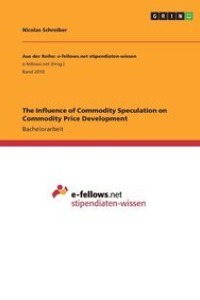
Liknande böcker
The Influence of Commodity Speculation on Commodity Price Development
Bok av Nicolas Schreiber
Bachelorarbeit aus dem Jahr 2014 im Fachbereich BWL - Bank, Börse, Versicherung, Johann Wolfgang Goethe-Universität Frankfurt am Main, Sprache: Deutsch, Abstract: Commodity prices have been rising significantly since the early 2000s with price growth reaching its fastest pace between 2006 and 2008. While nearly all commodities were hit by the aforementioned price spikes, price spikes where particularly pronounced for mineral commodities. For the most part of recent research two different approaches are applied to measure the impact of speculation on price development. The first one examines if there is any change in commodity price development due to the aforementioned increased financialization of commodity markets, whereas the second one compares the behavior of commodity prices with and without an existing futures market. This thesis combines both approaches and tests the hypotheses that either the first-time introduction of derivatives or the introductions of regulatory governmental acts that facilitate speculative index investment in commodities have significant effects on commodity price development by the example of copper traded on US-based exchanges. For this purpose, relevant copper price characteristics will be analyzed before and after possibly speculation-conducive events (i.e. the introduction of copper futures trading and two selected acts) for the period from 1971 to 2010. Furthermore, following Tang and Xiong (2012), this thesis examines if the introduction of governmental acts of the aforementioned type induces an increased market integration of non-energy commodity markets. This is of particular interest as market integration can at times induce increased volatility spillovers between the respective markets (Tang & Xiong, 2012). The first part of this work gives a short overview of the technical background necessary to understand the relationship between commodity prices and speculation. The second part provides a general review of related literature and research on the relationship between commodity prices and speculation. The third part focuses on the methodology of the empirical analysis. The fourth part of this work presents the results and is followed by the conclusion in part five.







